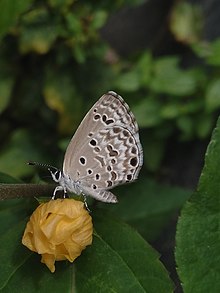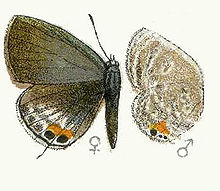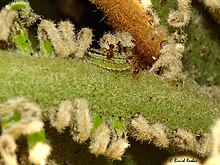440:"When full-grown a little over half an inch in length, of two distinct colours, some being bright green, others of a dark reddish purple (vinous) .... head very small, black, shining and hidden beneath the second segment, the third segment larger than the second, the other segments about equal in size, the anal segment flattened and rounded, divisions between the segments well-marked. The larva throughout is very rough, widely pitted or depressed and covered with very minute white tubercles bearing very short fine hairs, neither the hairs nor the tubercles being visible without a lens. The body at its highest and widest part is wider than high. It is extremely variable in its markings, hardly any two being exactly alike; there is usually a dark, dorsal, subdorsal and lateral line dividing the upper surface of the body into three equal areas, the dorsal and two subdorsal lines coalescing on the eleventh segment and forming a broad band to the thirteenth. In some specimens the divisions between the segments are marked with darker and there is a subdorsal series of oblique dark lines, one on each segment between the dorsal and subdorsal lines. The underside of the body and legs seems to be always green. The erectile organs on the twelfth segment very small, feeds in Calcutta on
305:, while the band on the hindwing in bisinuate and is capped anteriorly near the costa by a round black spot encircled with white; the above are followed by maculated (spotted) inner and outer subterminal bands, which on the hindwing are curved and more or less interrupted on the tornal area by a comparatively large round black spot in interspace 2 and a smaller similar spot in interspace 1, both spots inwardly crowned with ochraceous; the white edgings on the inner side to both subterminal bands on the hindwing are more or less lunular. In addition on the same wing there is a subbasal curved row of four white-encircled spots, of which the anterior two and the spot on the dorsum are black, the other dark brown. Antennae black, shafts ringed with white; head, thorax and abdomen brown, the head and thorax clothed with bluish hairs; beneath: palpi, thorax and abdomen whitish.
328:
352:
316:
340:
489:
470:"Of the usual Lycaenid form, quite smooth, more or less fuscous, with a darker dorsal and subdorsal line, head-case somewhat square, thorax slightly humped and constricted posteriorly, spiracles pale. Though the larva swarm in April and May in Calcutta on the cultivated cycads in gardens, eating the hardly opened shoots or fronds, thereby utterly destroying the appearance of the plant for the year, I have never succeeded in finding the pupa on the plants, and can only conclude that the ants drive the full-grown larvae down the stems of the plants into their nests, where the larvae undergo their transformations." (de Nicéville.)
301:
brown; a subterminal series of black spots outwardly edged by a white line; the spot in interspace 2 the largest and inwardly crowned more or less broadly with ochraceous yellow; an anteciliary black line and the cilia as on the forewing. Underside: greyish brown. Forewings and hindwings: the following transverse darker brown markings on each wing, the markings edged on the inner and outer sides with white lines—a short bar across the discocellulars, a discal catenulated (linked like a chain) band, the posterior two elongate spots of which on the forewing are
477:
221:
44:
309:
but the subterminal spots larger and not extended beyond interspace 6; in addition postdiscally there is a lightening of the shade of the ground colour, between which paler area and the subterminal spots the ground colour assumes the form of a postdiscal, short, transverse lunular band. Underside of female as in the male, the markings slightly larger and more clearly defined. Antennae, head, thorax and abdomen as in the male but slightly paler.
31:
433:
687:
657:
229:
308:
Female upperside: brown. Forewing: shot with blue from base outwards for a little over half its length down its middle, this blue irroration not extended to the costal margin; a slender anteciliary black line. Hindwing: a touch of blue iridescence near base; terminal markings much as on the forewing
300:
The male upperside is lavender blue. Forewing has the costa narrowly and terminal margin more broadly fuscous brown, the latter with in addition an anteciliary black line; cilia light brown transversely traversed close to but not at their bases by a dark brown line. Hindwing: costa narrowly fuscous
368:
length from base, but as in wet-season specimens not reaching the costal margin; on the hindwing the blue suffusion covers the entire medial portion of the wing from the base to the subterminal row of spots, of which latter the spot in interspace 2 is entirely without the inner ochraceous edging.
371:
Underside: ground colour darker than in specimens of the wet-season brood, the discocellular and discal transverse bands on both forewings and hindwings broader, the terminal markings very ill-defined, the inner white edging to the inner of the two subterminal transverse bands broadened and very
367:
Very similar to the same sexes of the wet-season brood, but can be recognized by the following differences: Upperside: Male ground colour slightly duller; subterminal spots on the hindwing less clearly defined. Female: The blue shot area extended outwards on the forewing for three-fourths of its
380:
The species resides in peninsular India south of the outer ranges of the
Himalayas, but not in the desert tracts and somewhat local; Ceylon: Assam: Burma; extending into the Malayan subregion.
488:
327:
523:
351:
804:
315:
339:
868:
778:
932:
594:
937:
476:
372:
diffuse. On the hindwing the discocellular and discal bands coalesce and form an ill-defined diffuse medial cloud on the wing.
927:
289:
894:
765:
610:
Ravikanthachari Nitin; V.C. Balakrishnan; Paresh V. Churi; S. Kalesh; Satya
Prakash; Krushnamegh Kunte (2018-04-10).
809:
43:
558:
Descriptive
Catalogue of the Lepidopterous Insects Contained in the Museum of the Horourable East-India Company
718:
666:
459:
770:
756:
922:
138:
670:
446:. In Calcutta three species of ants attend this larva, which Professor Forel has identified for me as
556:
700:
265:
611:
581:. New Delhi: Butterfly Research Centre, Bhimtal & Indinov Publishing, New Delhi. p. 143.
164:
38:
220:
817:
590:
822:
623:
582:
552:
155:
690:
One or more of the preceding sentences incorporates text from this source, which is in the
660:
One or more of the preceding sentences incorporates text from this source, which is in the
696:
628:
442:
233:
916:
691:
661:
576:
30:
741:
881:
791:
750:
432:
95:
849:
586:
257:
253:
105:
261:
115:
75:
55:
899:
860:
843:
783:
735:
873:
796:
273:
886:
276:
and the
Philippines. They are among the few butterflies that breed on
495:
85:
65:
712:
612:"Larval host plants of the butterfies of the Western Ghats, India"
431:
277:
228:
227:
219:
269:
716:
280:, known for their leaves being toxic to most vertebrates.
232:
Left, upperside of female; right underside of male, from
224:
Fight to mate; this behaviour is common among the blues.
833:
725:
578:A Synoptic Catalogue of the Butterflies of India
705:. London: Lovell Reeve and Co. pp. 37–39.
561:. London: East India Company. pp. 84–86.
8:
713:
672:Fauna of British India. Butterflies Vol. 2
570:
568:
29:
20:
651:
649:
647:
645:
643:
641:
639:
627:
575:R.K., Varshney; Smetacek, Peter (2015).
517:
515:
513:
509:
472:
311:
436:Cycad Cupid caterpillar tended by ants
532:Lepidoptera and Some Other Life Forms
7:
629:10.11609/jott.3104.10.4.11495-11550
14:
288:For a key to the terms used, see
260:, Myanmar, United Arab Emirates,
685:
655:
487:
475:
418:(Taiwan, Eastern China, Okinawa)
350:
338:
326:
314:
42:
1:
933:Butterflies described in 1829
702:Lepidoptera Indica. Vol. VIII
528:(Horsfield, [1829])"
413:Luthrodes pandava peripatria
290:Glossary of entomology terms
954:
616:Journal of Threatened Taxa
498:caterpillar tended by ants
287:
587:10.13140/RG.2.1.3966.2164
395:Luthrodes pandava vapanda
390:Luthrodes pandava pandava
170:
163:
144:
137:
39:Scientific classification
37:
28:
23:
938:Butterflies of Singapore
667:Bingham, Charles Thomas
404:Luthrodes pandava lanka
448:Prenolepis longicornis
437:
236:
225:
456:Crematogaster, n. sp.
435:
268:, Singapore, Taiwan,
231:
223:
200:Catochrysops bengalia
452:Monomorium speculare
208:Catochrysops vapanda
16:Species of butterfly
928:Butterflies of Asia
675:. pp. 413–415.
462:quoted in Bingham)
460:Lionel de Nicéville
333:Upper side (female)
266:Peninsular Malaysia
256:butterfly found in
192:Catochrysops nicola
622:(4): 11495–11550.
482:Female laying eggs
438:
357:Underside (female)
252:, is a species of
237:
226:
203:de Nicéville, 1885
910:
909:
818:Open Tree of Life
757:Luthrodes pandava
727:Luthrodes pandava
719:Taxon identifiers
632:– via JoTT.
596:978-81-929826-4-9
553:Horsfield, Thomas
526:Luthrodes pandava
417:
408:
399:
321:Upper side (male)
241:Luthrodes pandava
218:
217:
212:
204:
196:
178:
148:Luthrodes pandava
945:
903:
902:
890:
889:
877:
876:
864:
863:
854:
853:
852:
835:Chilades pandava
826:
825:
813:
812:
800:
799:
787:
786:
774:
773:
761:
760:
759:
746:
745:
744:
714:
707:
706:
697:Swinhoe, Charles
689:
688:
683:
677:
676:
659:
658:
653:
634:
633:
631:
607:
601:
600:
572:
563:
562:
549:
543:
542:
540:
538:
522:Savela, Markku.
519:
491:
479:
415:
406:
397:
363:Dry-season brood
354:
345:Underside (male)
342:
330:
318:
296:Wet-season brood
244:also called the
210:
202:
194:
187:Chilades pandava
176:
150:
47:
46:
33:
21:
953:
952:
948:
947:
946:
944:
943:
942:
913:
912:
911:
906:
898:
893:
885:
880:
872:
867:
859:
857:
848:
847:
842:
829:
821:
816:
808:
803:
795:
790:
782:
777:
769:
764:
755:
754:
749:
740:
739:
734:
721:
711:
710:
695:
686:
684:
680:
665:
656:
654:
637:
609:
608:
604:
597:
574:
573:
566:
551:
550:
546:
536:
534:
521:
520:
511:
506:
499:
492:
483:
480:
468:
430:
425:
386:
378:
365:
358:
355:
346:
343:
334:
331:
322:
319:
298:
293:
286:
174:Lycaena pandava
159:
152:
146:
133:
130:L. pandava
41:
17:
12:
11:
5:
951:
949:
941:
940:
935:
930:
925:
915:
914:
908:
907:
905:
904:
891:
878:
865:
855:
839:
837:
831:
830:
828:
827:
814:
801:
788:
775:
762:
747:
731:
729:
723:
722:
717:
709:
708:
678:
635:
602:
595:
564:
544:
508:
507:
505:
502:
501:
500:
493:
486:
484:
481:
474:
467:
464:
443:Cycas revoluta
429:
426:
424:
421:
420:
419:
410:
401:
398:(Semper, 1899)
392:
385:
382:
377:
374:
364:
361:
360:
359:
356:
349:
347:
344:
337:
335:
332:
325:
323:
320:
313:
297:
294:
285:
282:
234:Adalbert Seitz
216:
215:
214:
213:
205:
197:
189:
184:
182:Edales pandava
179:
168:
167:
161:
160:
153:
142:
141:
135:
134:
127:
125:
121:
120:
113:
109:
108:
103:
99:
98:
93:
89:
88:
83:
79:
78:
73:
69:
68:
63:
59:
58:
53:
49:
48:
35:
34:
26:
25:
15:
13:
10:
9:
6:
4:
3:
2:
950:
939:
936:
934:
931:
929:
926:
924:
921:
920:
918:
901:
896:
892:
888:
883:
879:
875:
870:
866:
862:
856:
851:
845:
841:
840:
838:
836:
832:
824:
819:
815:
811:
806:
802:
798:
793:
789:
785:
780:
776:
772:
767:
763:
758:
752:
748:
743:
737:
733:
732:
730:
728:
724:
720:
715:
704:
703:
699:(1910–1911).
698:
693:
692:public domain
682:
679:
674:
673:
668:
663:
662:public domain
652:
650:
648:
646:
644:
642:
640:
636:
630:
625:
621:
617:
613:
606:
603:
598:
592:
588:
584:
580:
579:
571:
569:
565:
560:
559:
554:
548:
545:
533:
529:
527:
518:
516:
514:
510:
503:
497:
490:
485:
478:
473:
471:
465:
463:
461:
457:
453:
449:
445:
444:
434:
427:
422:
414:
411:
407:(Evans, 1925)
405:
402:
400:(Philippines)
396:
393:
391:
388:
387:
383:
381:
375:
373:
369:
362:
353:
348:
341:
336:
329:
324:
317:
312:
310:
306:
304:
295:
291:
283:
281:
279:
275:
271:
267:
263:
259:
255:
251:
247:
243:
242:
235:
230:
222:
209:
206:
201:
198:
195:Swinhoe, 1885
193:
190:
188:
185:
183:
180:
175:
172:
171:
169:
166:
162:
157:
151:
149:
143:
140:
139:Binomial name
136:
132:
131:
126:
123:
122:
119:
118:
114:
111:
110:
107:
104:
101:
100:
97:
94:
91:
90:
87:
84:
81:
80:
77:
74:
71:
70:
67:
64:
61:
60:
57:
54:
51:
50:
45:
40:
36:
32:
27:
24:Plains Cupid
22:
19:
923:Polyommatini
834:
726:
701:
681:
671:
619:
615:
605:
577:
557:
547:
535:. Retrieved
531:
525:
469:
455:
451:
447:
441:
439:
412:
403:
394:
389:
379:
376:Distribution
370:
366:
307:
302:
299:
249:
246:Plains Cupid
245:
240:
239:
238:
211:Semper, 1890
207:
199:
191:
186:
181:
173:
147:
145:
129:
128:
116:
18:
882:iNaturalist
792:iNaturalist
751:Wikispecies
454:, Mayr and
416:(Hsu, 1989)
409:(Sri Lanka)
284:Description
177:Horsfield,
96:Lepidoptera
917:Categories
504:References
423:Life cycle
384:Subspecies
303:en echelon
258:South Asia
250:cycad blue
106:Lycaenidae
76:Arthropoda
784:104417890
742:Q65941001
450:, Latr.,
262:Indochina
156:Horsfield
124:Species:
117:Luthrodes
62:Kingdom:
56:Eukaryota
858:BioLib:
850:Q2963572
844:Wikidata
736:Wikidata
669:(1907).
555:(1829).
254:lycaenid
165:Synonyms
102:Family:
72:Phylum:
66:Animalia
52:Domain:
874:7346428
797:1097646
537:July 1,
274:Sumatra
158:, 1829)
112:Genus:
92:Order:
86:Insecta
82:Class:
887:130775
861:627023
823:415732
810:689490
771:504215
694::
664::
593:
496:instar
494:Early
278:cycads
900:12915
428:Larva
869:GBIF
805:NCBI
779:GBIF
766:BOLD
591:ISBN
539:2018
466:Pupa
270:Java
895:ISC
624:doi
583:doi
458:" (
248:or
919::
897::
884::
871::
846::
820::
807::
794::
781::
768::
753::
738::
638:^
620:10
618:.
614:.
589:.
567:^
530:.
512:^
272:,
264:,
626::
599:.
585::
541:.
524:"
292:.
154:(
Text is available under the Creative Commons Attribution-ShareAlike License. Additional terms may apply.







